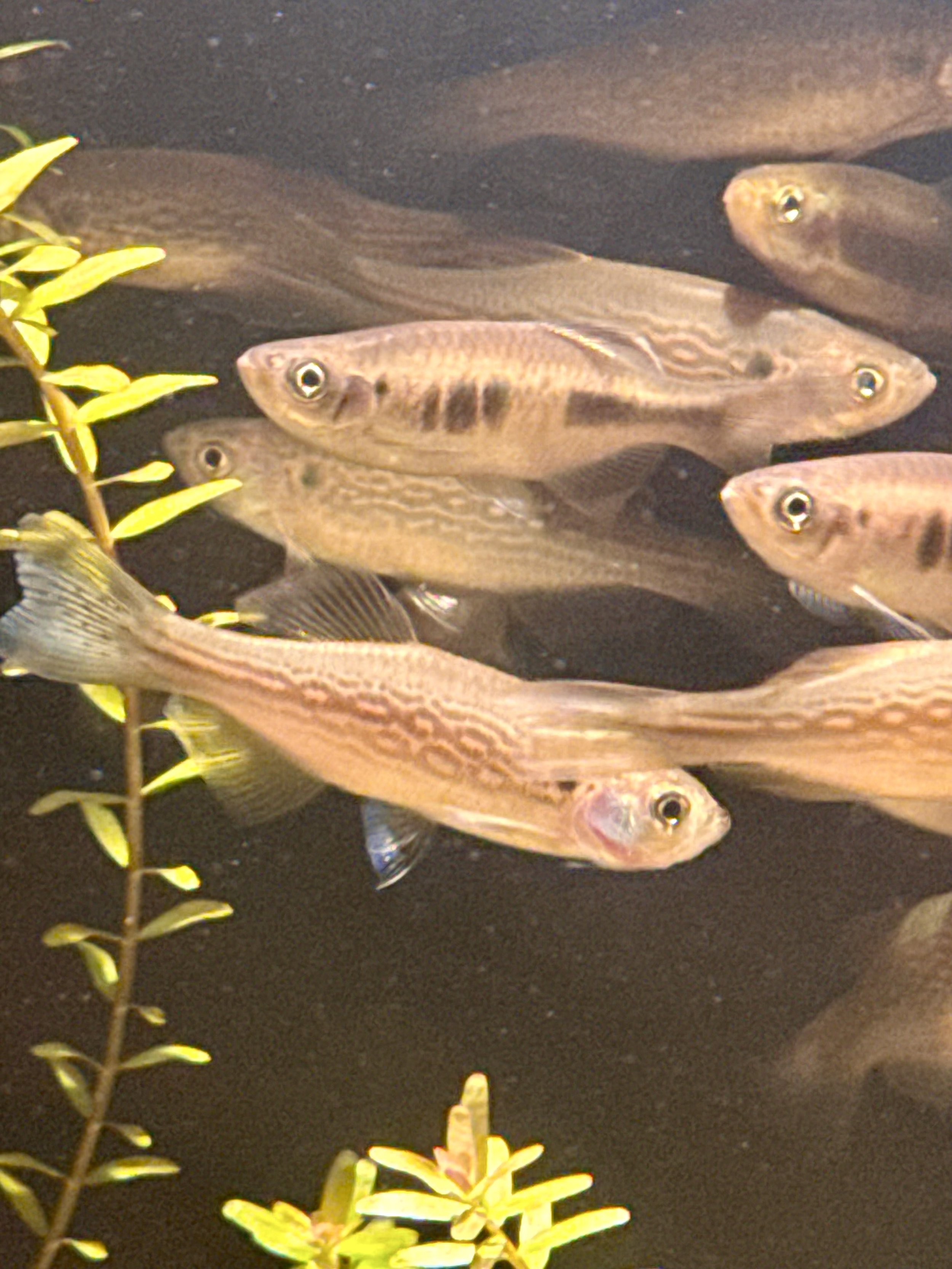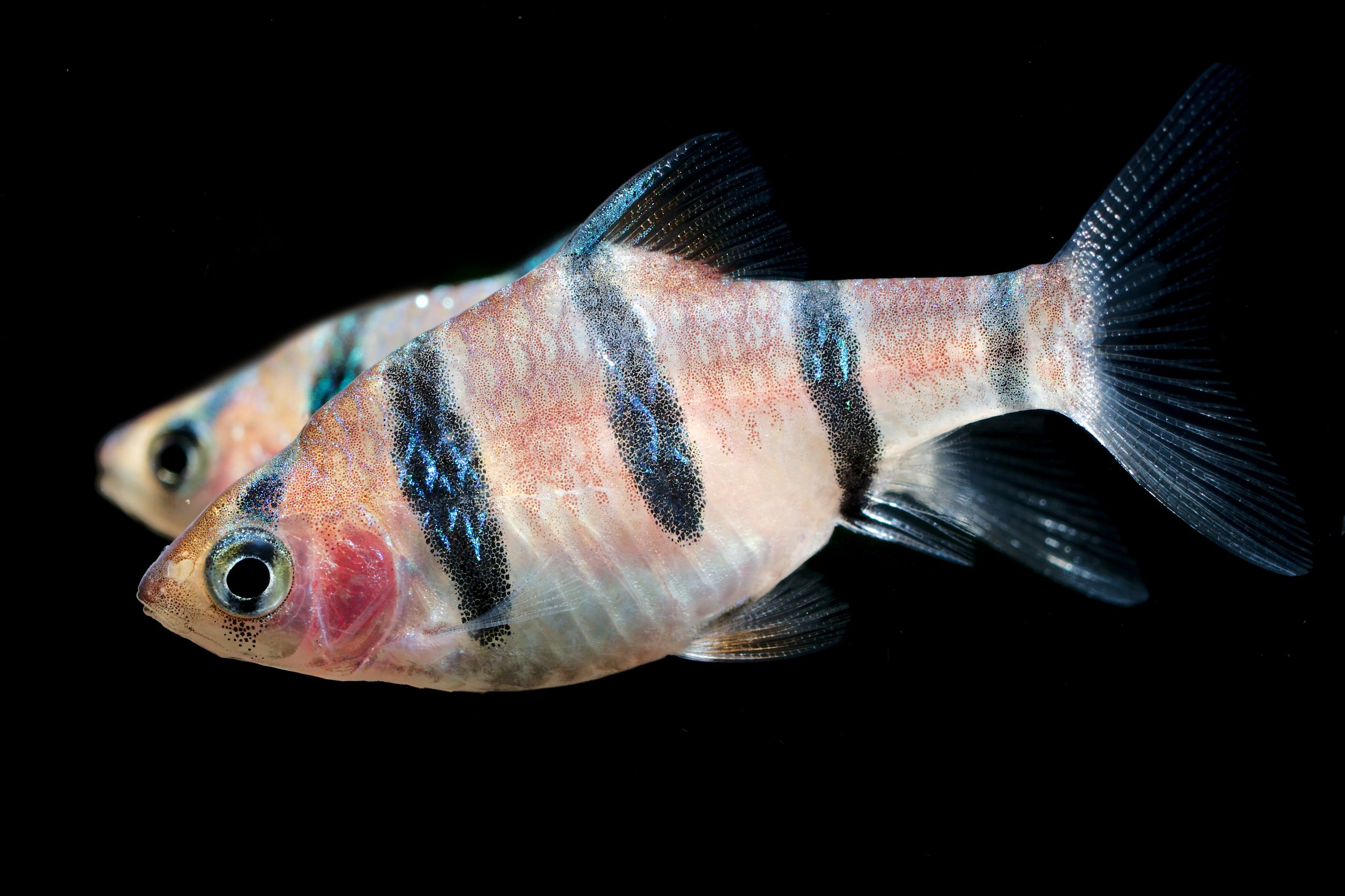 Image 1 of 3
Image 1 of 3

 Image 2 of 3
Image 2 of 3

 Image 3 of 3
Image 3 of 3




Cherry Barb
The Cherry Barb, scientifically known as Puntius titteya, is a vibrant and popular freshwater fish species cherished by aquarists for its striking coloration and peaceful nature. Originating from Sri Lanka, these beautiful barbs are a delightful addition to community aquariums, adding splashes of vibrant red to any aquatic landscape.
Physically, the Cherry Barb boasts a streamlined and elongated body adorned with vibrant hues of cherry red. Its body is often accented with contrasting black markings, particularly on the dorsal fin and tail, adding to its visual appeal. Mature specimens typically reach lengths of around 1.5 to 2 inches (3.8 to 5 centimeters), making them well-suited for a wide range of aquarium setups.
In aquariums, Cherry Barbs thrive in well-planted tanks with plenty of open swimming space. They appreciate a substrate of fine gravel or sand and benefit from the presence of driftwood, rocks, and live plants, which provide hiding spots and mimic their natural habitat. These barbs are also known for their lively and active behavior, making them a joy to watch as they explore their surroundings.
Water parameters for Cherry Barbs should closely resemble those of their native habitat, with temperatures ranging from 73 to 81°F (23 to 27°C) and slightly acidic to neutral pH levels between 6.0 to 7.5. Regular water changes and maintenance help maintain pristine water conditions and ensure the well-being of these fish.
Feeding Cherry Barbs is relatively straightforward, as they are omnivorous and accept a wide variety of foods. They eagerly consume high-quality flakes, pellets, and granules, as well as live or frozen foods such as bloodworms, brine shrimp, and daphnia. Offering a varied diet ensures that they receive essential nutrients and helps promote their overall health and vitality.
Breeding Cherry Barbs in captivity is relatively easy and often occurs spontaneously in well-maintained aquariums. A separate breeding tank with soft, acidic water and fine-leaved plants like java moss or spawning mops provides an ideal spawning environment. Once eggs are laid and fertilized, the parents do not exhibit parental care, so it's advisable to remove them to prevent predation on the eggs. The eggs typically hatch within 24 to 36 hours, and the fry can be raised on a diet of infusoria and powdered fry food until they are large enough to consume larger fare.
Overall, the Cherry Barb is a charming and colorful addition to freshwater aquariums, prized for its beauty, peaceful demeanor, and ease of care. With proper attention to their specific requirements, these delightful barbs can thrive and bring joy to aquarists of all levels of experience, enhancing the beauty and vibrancy of any aquatic environment.
The Cherry Barb, scientifically known as Puntius titteya, is a vibrant and popular freshwater fish species cherished by aquarists for its striking coloration and peaceful nature. Originating from Sri Lanka, these beautiful barbs are a delightful addition to community aquariums, adding splashes of vibrant red to any aquatic landscape.
Physically, the Cherry Barb boasts a streamlined and elongated body adorned with vibrant hues of cherry red. Its body is often accented with contrasting black markings, particularly on the dorsal fin and tail, adding to its visual appeal. Mature specimens typically reach lengths of around 1.5 to 2 inches (3.8 to 5 centimeters), making them well-suited for a wide range of aquarium setups.
In aquariums, Cherry Barbs thrive in well-planted tanks with plenty of open swimming space. They appreciate a substrate of fine gravel or sand and benefit from the presence of driftwood, rocks, and live plants, which provide hiding spots and mimic their natural habitat. These barbs are also known for their lively and active behavior, making them a joy to watch as they explore their surroundings.
Water parameters for Cherry Barbs should closely resemble those of their native habitat, with temperatures ranging from 73 to 81°F (23 to 27°C) and slightly acidic to neutral pH levels between 6.0 to 7.5. Regular water changes and maintenance help maintain pristine water conditions and ensure the well-being of these fish.
Feeding Cherry Barbs is relatively straightforward, as they are omnivorous and accept a wide variety of foods. They eagerly consume high-quality flakes, pellets, and granules, as well as live or frozen foods such as bloodworms, brine shrimp, and daphnia. Offering a varied diet ensures that they receive essential nutrients and helps promote their overall health and vitality.
Breeding Cherry Barbs in captivity is relatively easy and often occurs spontaneously in well-maintained aquariums. A separate breeding tank with soft, acidic water and fine-leaved plants like java moss or spawning mops provides an ideal spawning environment. Once eggs are laid and fertilized, the parents do not exhibit parental care, so it's advisable to remove them to prevent predation on the eggs. The eggs typically hatch within 24 to 36 hours, and the fry can be raised on a diet of infusoria and powdered fry food until they are large enough to consume larger fare.
Overall, the Cherry Barb is a charming and colorful addition to freshwater aquariums, prized for its beauty, peaceful demeanor, and ease of care. With proper attention to their specific requirements, these delightful barbs can thrive and bring joy to aquarists of all levels of experience, enhancing the beauty and vibrancy of any aquatic environment.
The Cherry Barb, scientifically known as Puntius titteya, is a vibrant and popular freshwater fish species cherished by aquarists for its striking coloration and peaceful nature. Originating from Sri Lanka, these beautiful barbs are a delightful addition to community aquariums, adding splashes of vibrant red to any aquatic landscape.
Physically, the Cherry Barb boasts a streamlined and elongated body adorned with vibrant hues of cherry red. Its body is often accented with contrasting black markings, particularly on the dorsal fin and tail, adding to its visual appeal. Mature specimens typically reach lengths of around 1.5 to 2 inches (3.8 to 5 centimeters), making them well-suited for a wide range of aquarium setups.
In aquariums, Cherry Barbs thrive in well-planted tanks with plenty of open swimming space. They appreciate a substrate of fine gravel or sand and benefit from the presence of driftwood, rocks, and live plants, which provide hiding spots and mimic their natural habitat. These barbs are also known for their lively and active behavior, making them a joy to watch as they explore their surroundings.
Water parameters for Cherry Barbs should closely resemble those of their native habitat, with temperatures ranging from 73 to 81°F (23 to 27°C) and slightly acidic to neutral pH levels between 6.0 to 7.5. Regular water changes and maintenance help maintain pristine water conditions and ensure the well-being of these fish.
Feeding Cherry Barbs is relatively straightforward, as they are omnivorous and accept a wide variety of foods. They eagerly consume high-quality flakes, pellets, and granules, as well as live or frozen foods such as bloodworms, brine shrimp, and daphnia. Offering a varied diet ensures that they receive essential nutrients and helps promote their overall health and vitality.
Breeding Cherry Barbs in captivity is relatively easy and often occurs spontaneously in well-maintained aquariums. A separate breeding tank with soft, acidic water and fine-leaved plants like java moss or spawning mops provides an ideal spawning environment. Once eggs are laid and fertilized, the parents do not exhibit parental care, so it's advisable to remove them to prevent predation on the eggs. The eggs typically hatch within 24 to 36 hours, and the fry can be raised on a diet of infusoria and powdered fry food until they are large enough to consume larger fare.
Overall, the Cherry Barb is a charming and colorful addition to freshwater aquariums, prized for its beauty, peaceful demeanor, and ease of care. With proper attention to their specific requirements, these delightful barbs can thrive and bring joy to aquarists of all levels of experience, enhancing the beauty and vibrancy of any aquatic environment.







